| Revision as of 11:01, 12 October 2014 edit182.182.109.110 (talk) →Religions← Previous edit | Revision as of 12:17, 12 October 2014 edit undoZambelo (talk | contribs)2,921 edits no.Next edit → | ||
| Line 108: | Line 108: | ||
| Guangzhou is the third largest Chinese city and the largest city in ]. As of the 2010 census, the city's administrative area had a population of 12.78 million.<ref>{{cite web|author= Th. Brinkhoff |url=http://www.citypopulation.de/world/Agglomerations.html |title=The Principal Agglomerations of the World – Population Statistics & Maps |publisher=Citypopulation.de |date=2011-04-05 |accessdate=2011-08-13}}</ref> Some estimates place the population of the entire ] built up area as high as 40 million including ] (''10.36 million''), ] (''8.22 million'') and most parts of ] (''7.19 million''), ] (''4.45 million''), ] (''3.12 million'') and a small part of ] adjoining Dongguan and Shenzhen, with an area of about {{Convert|20000|km2|mi2}}. | Guangzhou is the third largest Chinese city and the largest city in ]. As of the 2010 census, the city's administrative area had a population of 12.78 million.<ref>{{cite web|author= Th. Brinkhoff |url=http://www.citypopulation.de/world/Agglomerations.html |title=The Principal Agglomerations of the World – Population Statistics & Maps |publisher=Citypopulation.de |date=2011-04-05 |accessdate=2011-08-13}}</ref> Some estimates place the population of the entire ] built up area as high as 40 million including ] (''10.36 million''), ] (''8.22 million'') and most parts of ] (''7.19 million''), ] (''4.45 million''), ] (''3.12 million'') and a small part of ] adjoining Dongguan and Shenzhen, with an area of about {{Convert|20000|km2|mi2}}. | ||
| In 2012 Guangzhou was identified as a ] by the global city index produced by the ], the Globalization and World Cities Research Network.<ref>{{cite web|url=http://www.foreignpolicy.com/articles/2008/10/15/the_2008_global_cities_index |title=The 2008 Global Cities Index |publisher=Foreign Policy |date=2008-10-15 |accessdate=2011-06-02}}</ref> | |||
| ==History== | ==History== | ||
Revision as of 12:17, 12 October 2014
For other uses, see Guangzhou (disambiguation).Sub-provincial city in Guangdong, People's Republic of China
| Guangzhou 广州市 | |
|---|---|
| Sub-provincial city | |
 From top: Tianhe CBD, the Canton Tower & Chigang Pagoda, Haizhu Bridge, Sun Yat-sen Memorial Hall, Statue of Five Goats, Zhenhai Tower in Yuexiu Park, and Sacred Heart Cathedral. From top: Tianhe CBD, the Canton Tower & Chigang Pagoda, Haizhu Bridge, Sun Yat-sen Memorial Hall, Statue of Five Goats, Zhenhai Tower in Yuexiu Park, and Sacred Heart Cathedral. | |
 Location of Guangzhou in Guangdong Location of Guangzhou in Guangdong | |
| Country | People's Republic of China |
| Province | Guangdong |
| Government | |
| • Type | Sub-provincial city |
| • CPC Ctte Secretary | Ren Xuefeng |
| • Mayor | Chen Jianhua |
| Area | |
| • Sub-provincial city | 7,434 km (2,870 sq mi) |
| • Urban | 3,843 km (1,484 sq mi) |
| Elevation | 21 m (68 ft) |
| Population | |
| • Sub-provincial city | 14,000,000 |
| • Density | 1,883/km (4,877/sq mi) |
| • Urban | 11,070,654 |
| Demonym(s) | Guangzhouese Cantonese |
| Time zone | UTC+8 (China standard time) |
| Postal code | 510000 |
| Area codes | +86 (0)20 |
| GDP | 2013 |
| - Total | CN¥1,524 billion (US$248.61 billion) |
| - Per capita | CN¥120,515 (US$19,459) |
| - Growth | |
| Licence plate prefixes | 粤A |
| Flower | Bombax ceiba |
| Bird | Chinese Hwamei |
| Website | english |
| Guangzhou | |||||||||||||||||||||||||||||||
|---|---|---|---|---|---|---|---|---|---|---|---|---|---|---|---|---|---|---|---|---|---|---|---|---|---|---|---|---|---|---|---|
 "Guangzhou", as written in Traditional Chinese and Simplified Chinese "Guangzhou", as written in Traditional Chinese and Simplified Chinese | |||||||||||||||||||||||||||||||
 Bombax ceiba, the official flower of Guangzhou Bombax ceiba, the official flower of Guangzhou | |||||||||||||||||||||||||||||||
| Simplified Chinese | 广州 | ||||||||||||||||||||||||||||||
| Traditional Chinese | 廣州 | ||||||||||||||||||||||||||||||
| Jyutping | Gwong zau | ||||||||||||||||||||||||||||||
| Cantonese Yale | Gwóngjàu | ||||||||||||||||||||||||||||||
| Hanyu Pinyin | Guǎngzhōu | ||||||||||||||||||||||||||||||
| Postal | Canton | ||||||||||||||||||||||||||||||
| |||||||||||||||||||||||||||||||
Guangzhou (also romanized as: Canton; less-commonly known as Kwangchow) is the capital and largest city of Guangdong province in South China. Located on the Pearl River, about 120 km (75 mi) north-northwest of Hong Kong and north-northeast of Macau, Guangzhou is a key national transportation hub and trading port. One of the five National Central Cities, it holds sub-provincial administrative status.
Guangzhou is the third largest Chinese city and the largest city in South Central China. As of the 2010 census, the city's administrative area had a population of 12.78 million. Some estimates place the population of the entire Pearl River Delta Mega City built up area as high as 40 million including Shenzhen (10.36 million), Dongguan (8.22 million) and most parts of Foshan (7.19 million), Jiangmen (4.45 million), Zhongshan (3.12 million) and a small part of Huizhou adjoining Dongguan and Shenzhen, with an area of about 20,000 square kilometres (7,700 sq mi). In 2012 Guangzhou was identified as a Beta+ World City by the global city index produced by the GaWC, the Globalization and World Cities Research Network.
History
See also: Timeline of Guangzhou historyEarly history
Guangzhou's earliest recorded name is Panyu (Chinese: 番禺; Jyutping: Pun Jyu), derived from two nearby mountains known as Pan and Yu in ancient times. Its recorded history begins with China's conquest of the area during the Qin dynasty. Panyu expanded when it became capital of the Nanyue Kingdom in 206 BC; the territory of Nanyue included what is now northern Vietnam.
The Han dynasty annexed the Nanyue Kingdom in 111 BC during the empire's expansion southward, and Panyu became a provincial capital and remains so today. In 226 AD, Panyu became the seat of Guang Prefecture (廣州; Guangzhou / 廣府; Guangfu). While originally referring to the prefecture alone, local citizens gradually adopted the custom of using the same name for their city.
Although Guangzhou replaced Panyu as the name of the walled city, Panyu was still the name of the surrounding area until the end of Qing dynasty. Today, Panyu is a district of Guangzhou south of Haizhu District separated from the rest of the city by the Pearl River.
The Old Book of Tang described Guangzhou as important port in the south of China. In that period, direct routes connected the Middle East and China. A Chinese prisoner, who was captured in the Battle of Talas and stayed in what is now Iraq for twelve years, returned to China by ship on a direct route from Iraq to Guangzhou. Guangzhou was mentioned by various Muslim geographers in the ninth and tenth centuries, such as Al-Masudi and Ibn Khordadbeh. According to a local Guangzhou government report, the city was sacked by Muslims on October 30, 758. The Arab historian Abu Zayd as-Sirafi mentioned Guangzhou several times in his book The Journey of as-Sirafi (Arabic:رحلة السيرافي), providing a description of daily life, food, business dealings, and the justice system of the city. As-Sirafi also reports that in 878 followers of the Chinese rebel leader Huang Chao besieged Guangzhou and massacred a large number of foreign merchants residing there. The foreign merchants were Arab Muslims, Persians, Jews and Christians
During the Five Dynasties and Ten Kingdoms Period, Guangzhou was the capital of the Southern Han state which existed from 917 to 971, and was one of the most stable of the southern states. The region enjoyed considerable cultural and economic success in this period.
From the tenth to twelfth century, Persian women were to be found in Guangzhou. Multiple women originating from the Persian Gulf lived in Guangzhou's foreign quarter. Some scholars did not differentiate between Persian and Arab, calling them both "Da Yi" (Chinese: 大食; pinyin: Dà Yì), and some say that the Chinese called all women coming from the Persian Gulf "Persian Women".
The Moroccan traveler Ibn Battuta visited Guangzhou in the 14th century in his journey around the world. He described the manufacturing process of large ships in the city.
During the Northern Song dynasty, the celebrated poet Su Shi (Shisu) visited Guangzhou's Baozhuangyan Temple and wrote the inscription "Liu Rong" (Six Banyan Trees) because of the six banyan trees he saw there. It has since been called the Temple of the 6 Banyan Trees.
The Portuguese were the first Europeans to arrive in Guangzhou by sea in 1514, establishing a monopoly on the external trade out of its harbour by 1517. They were later expelled from their settlements in Guangzhou (Cantão in Portuguese), but instead were granted use of Macau as a trade base with the city in 1557. They would keep a near monopoly on foreign trade in the region until the arrival of the Dutch in the early 17th century.
17th through 19th centuries
It is believed that the romanisation "Canton" originated from the Template:Lang-pt, which was transcribed from Guangdong. Nevertheless, because at the time of the Portuguese arrival, the capital city had no specific appellation other than the provincial capital (Chinese: 省城; pinyin: shěng chéng; Jyutping: Shaang Sheng) by its people, the province name was adopted for the walled city by the Europeans. The etymology of Canton, as well as the similar pronunciation with the province name Guangdong might have partly contributed to the recent confusion of Canton and Guangdong by certain English speakers.
In Guangzhou, the national monuments known as "The Muslim's Loyal Trio" are the tombs of Ming loyalist Muslims who were martyred while fighting in battle against the Qing in Guangzhou.
After China gained control of Taiwan in 1683, the Qing government became more open to foreign trade. Guangzhou quickly emerged as one of the most suitable ports for international trade and before long ships arrived from all over the world.
The Portuguese in Macau, the Spanish in Manila, Arabs from the Middle East and Muslims from India were already actively trading in the port by the 1690s, when the French and English began frequenting the port through the Canton System.
Other companies were soon to follow: the Ostend General India company in 1717; Dutch East India Company in 1729; the first Danish ship in 1731, which was followed by a Danish Asiatic Company ship in 1734; the Swedish East India Company in 1732; followed by an occasional Prussian and Trieste Company ship; the Americans in 1784; and the first ships from Australia in 1788.

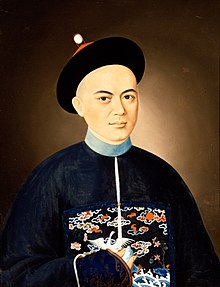
By the middle of the 18th century, Guangzhou had emerged as one of the world's great trading ports under the Thirteen Factories, which was a distinction it maintained until the outbreak of the First Opium War in 1839 and the opening of other ports in China in 1842. The privilege during this period made Guangzhou one of the top 3 cities in the world. During the war, the British captured Canton on March 18, 1841. The Second Battle of Canton was fought in May 1841.

From 1855 to 1867 there were a series of battles between the Punti and Hakka peoples known as the Punti-Hakka Clan Wars (土客械鬥).
The plague epidemic – part of the Third Pandemic – reached Guangzhou in 1894, causing the death of 60,000 people in a few weeks. In 1918, the city's urban council was established and Guangzhou (Chinese: 廣州; Jyutping: Gwong zau) became the official name of the city in Chinese. Panyu became a country's name to the southern side of Guangzhou.
1930–present
Japanese troops occupied Guangzhou from 21 October 1938, to 16 September 1945, after bombing the city. The Imperial Japanese Army conducted bacteriological research in Guangzhou under Unit 8604, a section of Unit 731.
After the fall of the capital Nanjing in April 1949, the Nationalist government under the acting president Li Zongren relocated to Guangzhou.
Communist forces entered the city on 14 October 1949. The Nationalists blew up the Haizhu Bridge, an important passage across the Pearl River, in order to slow the Communist advance and allow the government to flee to Chongqing. The communist government soon renamed the city's English name to "Guangzhou". A massive exodus followed as many fled to nearby Hong Kong and Macau, and the provincial capital's international status dwindled. The urban renewal projects of the new communist government improved the lives of some residents. New housing on the shores of the Pearl River provided homes for the poor boat people. Reforms by Deng Xiaoping, who came to power in the late 1970s, led to rapid economic growth due to the city's close proximity to Hong Kong and access to the Pearl River.
As labour costs increased in Hong Kong and China liberalized its economy, manufacturers opened new plants in Guangdong, including Guangzhou. As the largest city in one of China's wealthiest provinces, Guangzhou attracts farmers from the countryside looking for factory work. Cantonese links to overseas Chinese and beneficial tax reforms in the 1990s contributed to the city's rapid growth.
In 2000, Huadu and Panyu were merged into Guangzhou as districts, and Conghua and Zengcheng became county-level cities of Guangzhou.
-
 Street view of Canton (Guangzhou in 1860s)
Street view of Canton (Guangzhou in 1860s)
-
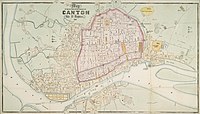 The map of Guangzhou in 1860
The map of Guangzhou in 1860
-
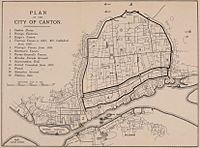 Plan of Canton (published 1910)
Plan of Canton (published 1910)
-
 Street scene in Canton, 1919
Street scene in Canton, 1919
- Canton, 1937
Geography
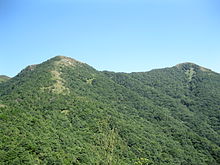
Located in the south-central portion of Guangdong, Guangzhou spans from 112° 57' to 114° 03' E longitude and 22° 26' to 23° 56' N latitude. The city is part of the Pearl River Delta and the city centre is situated next to the Baiyun Mountain, which is locally referred to as "the lung of the city" (市肺). The total area under the city's administration is 7,434.4 square kilometres (2,870.4 sq mi).
The elevation of the prefecture generally increases from southwest to northeast, with mountains forming the backbone of the city, and the ocean comprising the front. Tiantang Peak (天堂顶, meaning Peak of Paradise in Chinese), which stands 1,210 m (3,970 ft) above sea level, is the highest mountain in Guangzhou.
Climate
Located just south of the Tropic of Cancer, Guangzhou has a humid subtropical climate (Köppen Cfa) influenced by the East Asian monsoon. Summers are wet with high temperatures, high humidity, and a high heat index. Winters are mild and comparatively dry. Guangzhou has a lengthy monsoon season, spanning from April through September. Monthly averages range from 13.6 °C (56.5 °F) in January to 28.6 °C (83.5 °F) in July, while the annual mean is 22.6 °C (72.7 °F), the relative humidity is approximately 68 percent, whereas annual rainfall in the metropolitan area is over 1,700 mm (67 in). With monthly percent possible sunshine ranging from 17 percent in March and April to 52 percent in November, the city receives 1,628 hours of bright sunshine annually, considerably less than nearby Shenzhen and Hong Kong. Extreme temperatures have ranged from 0 °C (32 °F) to 39.1 °C (102 °F). The last recorded snowfall in the city was in January 1893.
Administrative divisions
Main article: List of administrative divisions of Guangzhou| Year | Pop. | ±% |
|---|---|---|
| 1953 | 1,598,900 | — |
| 1964 | 3,031,486 | +89.6% |
| 1982 | 5,630,733 | +85.7% |
| 1990 | 6,299,943 | +11.9% |
| 1995 | 8,117,100 | +28.8% |
| 2000 | 9,942,022 | +22.5% |
| 2002 | 10,106,229 | +1.7% |
| 2005 | 9,496,800 | −6.0% |
| 2006 | 9,966,600 | +4.9% |
| 2007 | 10,530,100 | +5.7% |
| 2008 | 11,153,400 | +5.9% |
| 2009 | 11,869,700 | +6.4% |
| 2010 | 12,709,600 | +7.1% |
| 2011 | 12,751,400 | +0.3% |
| Population size may be affected by changes on administrative divisions. | ||
Guangzhou is a sub-provincial city. It has direct jurisdiction over eleven districts:
| Map | |||||
|---|---|---|---|---|---|
 Liwan
Yuexiu
Haizhu
Tianhe
Baiyun
Huangpu
Panyu
Huadu
Nansha
Zengcheng
Conghua
Liwan
Yuexiu
Haizhu
Tianhe
Baiyun
Huangpu
Panyu
Huadu
Nansha
Zengcheng
Conghua
| |||||
| Name | Simplified Chinese | Hanyu Pinyin | Population (2010 census) |
Area (km) |
Density (/km) |
| Yuexiu District | 越秀区 | Yuèxiù Qū | 1,157,277 | 33.80 | 34,239 |
| Liwan District | 荔湾区 | Lìwān Qū | 898,204 | 59.10 | 15,198 |
| Haizhu District | 海珠区 | Hǎizhū Qū | 1,558,663 | 90.40 | 17,242 |
| Tianhe District | 天河区 | Tiānhé Qū | 1,432,431 | 96.33 | 14,870 |
| Baiyun District | 白云区 | Báiyún Qū | 2,222,658 | 795.79 | 2,793 |
| Huangpu District | 黄埔区 | Huángpù Qū | 831,600 | 484.17 | 1,717 |
| Panyu District | 番禺区 | Pānyú Qū | 1,764,869 | 786.15 | 2,245 |
| Huadu District | 花都区 | Huādū Qū | 945,053 | 970.04 | 974 |
| Nansha District | 南沙区 | Nánshā Qū | 259,899 | 527.65 | 493 |
| Zengcheng District | 增城区 | Zēngchéng Qū | 1,036,731 | 1,616.47 | 641 |
| Conghua District | 从化区 | Cónghuà Qū | 593,415 | 1,974.50 | 301 |
| Total | 12,700,800 | 7,434.40 | 1,708 | ||
As of April 28, 2005, the districts of Dongshan and Fangcun have been abolished and merged into Yuexiu and Liwan respectively; at the same time the district of Nansha was established out of parts of Panyu, and the district of Luogang was established out of parts of Baiyun, Tianhe, and Zengcheng, plus a part of Huangpu, making an exclave next to Huangpu.
Merger with Foshan
In January 2009 the National People's Congress approved a development plan for the Pearl River Delta Region. On March 19, 2009 the Guangzhou Municipal Government and Foshan Municipal Government both agreed to establish a framework to merge the two cities.
Significant buildings
 Panorama of Guangzhou
Panorama of Guangzhou
 Panorama of Guangzhou at night
See also: List of tallest buildings in Guangzhou
Panorama of Guangzhou at night
See also: List of tallest buildings in Guangzhou
- Guangdong Olympic Stadium
- CITIC Plaza
- Canton Tower
- Guangzhou Opera House
- Guangzhou TV Tower
- Pearl River Tower
- Guangzhou Circle Mansion
- Guangzhou Twin Towers:
Economy

Guangzhou is the main manufacturing hub of the Pearl River Delta, one of mainland China's leading commercial and manufacturing regions. In 2013, the GDP reached¥ 1542 billion (US$248.billion), per capita was ¥120,515 (US $19,459).
The China Import and Export Fair, also called the "Canton Fair", is held every year in April and October by the Ministry of Trading. Inaugurated in the spring of 1957, the Fair is a major event for the city. From the 104th session onwards, the Fair moved to the new Pazhou complex, from the older Liuhua Complex. All booths have been transferred to Pazhou Complex, which is served by two stations on Metro Line 8. Also, since the 104th session, the Canton Fair has been arranged in 3 phases instead of 2 phases.
Industrial zones
- Guangzhou Economic and Technological Development Zone
- Guangzhou Nansha Export Processing Zone
The zone was founded in 2005. Its total planned area is 1.36 km (0.53 sq mi). It is located in Nansha District and it belongs to the provincial capital, Guangzhou. The major industries encouraged in the zone include auto-mobile assembly, biotechnology and heavy industry. It is situated near to Guangzhou Baiyun International Airport and Shenzhen Port.
- Guangzhou Free Trade Zone
The zone was founded in 1992. It is located in the east of Huangpu District and located near to Guangzhou Economic and Technological Development Zone. It is situated very close to Guangzhou Baiyun Airport. The major industries encouraged in the zone include international trade, logistics, processing industry and computer software. Guangzhou is considered one of the most prosperous cities in China. But due to rapid industrialization, it is also considered one of the most polluted cities.
Science City
Malls and pedestrian streets

- 101 Dynamics
- Beijing Lu
- China Plaza
- Jiangnanxi
- Liwan Plaza
- Shangxiajiu
- Teem Plaza
- Victory Plaza
- Wanguo Plaza
- Zhengjia Square (Grandview Mall)
- Wanda square
- Happy Valley (Guangzhou)
Transportation




Public transport
Guangzhou Metro
Main article: Guangzhou MetroWhen the first line of the Guangzhou Metro opened in 1997, Guangzhou was the fourth city in Mainland China to have an underground railway system, behind Beijing, Tianjin and Shanghai. Currently the metro network is made up of nine lines, covering a total length of 260 km (160 mi). A long term plan is to make the city's metro system expand to over 500 km (310 mi) by 2020 with 15 lines in operation.
As of July 2014 the lines of Guangzhou Metro include:
- Line 1: Guangzhou East Railway Station–Xilang Station
- Line 2: Jiahewanggang Station–Guangzhou South Railway Station
- Line 3
- South route: Tianhe Coach Terminal Station–Panyu Square Station via Tiyu Xilu Station
- North route: Airport South Station–Tiyu Xilu Station
- Line 4: Huangcun Station–Jinzhou Station
- Line 5: Jiaokou Station–Wenchong Station
- Line 6: Xunfenggang Station–Changban Station
- Line 8: Fenghuang Xincun Station–Wanshengwei Station
- Guangfo Line: Xilang Station–Kuiqi Lu Station
- APM: Linhexi Station–Canton Tower Station
Buses, taxis and motorcycles
See also: List of Bus Routes in GuangzhouThe Guangzhou Bus Rapid Transit (or GBRT) system which was introduced in 2010, is the world's second largest Bus Rapid Transit system with 1,000,000 passenger trips daily and 26,900 pphpd during the peak hour (second only to the TransMilenio BRT system in Bogota). The system averages 1 bus every 10 seconds or 350 per hour in a single direction and contains the world's longest BRT stations—around 260 m (850 ft) including bridges.
In 2009, is was reported that all 9,424 buses and 17,695 taxis in Guangzhou would be operating on LPG-fuel by 2010 to promote clean energy for transport and improve the environment ahead of the 2010 Asian Games which were held in the city. At present, Guangzhou is the city that uses the most LPG-fueled vehicles in the world, and at the end of 2006, 6,500 buses and 16,000 taxis were using LPG, taking up 85 percent of all buses and taxis. It can be not fully true, because in countries like Poland, cars with LPG(especially taxis), are very popular, and by percentage some cities had higher usage of buses.
Effective January 1, 2007, the municipal government has banned motorcycles in urban areas. Motorcycles found violating the ban will be confiscated. The Guangzhou traffic bureau claimed to have reported reduced traffic problems and accidents in the downtown area since the ban.
Air transport
Guangzhou's main airport is the Baiyun International Airport in Huadu District opened on August 5, 2004. This airport is also the 2nd busiest airport in terms of traffic movements in China. It replaced the old Baiyun International Airport, which was very close to the city centre and failed to meet the fast-growing air traffic demand.
Guangzhou Baiyun International Airport now has two runways, with three more planned to be built.
Railway transport
Further information: Guangzhou Station, Guangzhou East Station, Guangzhou South Station, and Guangzhou North StationGuangzhou is the terminus of the Jingguang railway (Beijing–Guangzhou), the Guangshen railway (Guangzhou–Shenzhen), the Guangmao railway (Guangzhou–Maoming) and the Guangmeishan railway (Guangzhou–Meizhou–Shantou). In late 2009, the Wuhan–Guangzhou High-Speed Railway started its service, which enables multiple unit trains to cover 980 km (608.94 mi) at a top speed of 320 km/h (199 mph). In January 2011, the Guangzhou–Zhuhai Intercity Railway started its service at an average speed of 200 km/h (124 mph).
Intercity transport to Hong Kong
Guangzhou is well connected to Hong Kong by train, coach and ferry. The Guangdong Through Train departs from the Guangzhou East railway station and arrives at the Hung Hom KCR station in Kowloon, Hong Kong. The route is approximately 182 km (113 mi) in length and the ride takes less than two hours. Frequent coach services are also provided with coaches departing every day from different locations (mostly major hotels) around the city.
River transport

There are daily high-speed catamaran services between Nansha Ferry Terminal and Lianhua Shan Ferry Terminal in Guangzhou and the Hong Kong China Ferry Terminal, as well as between Nansha Ferry Terminal and Macau Ferry Pier in Hong Kong.
Local products
- Canton Province Sculpture is legendary and includes Guangzhou Ivory Carvings, Jade Sculpture, Wood Sculpture and Olive Sculpture.
- Cantonese Enamel includes Guangzhou Colorful Pottery. It has a history of over 300 years.
- Cantonese Embroidery (Chinese: 粤绣; pinyin: yuè xiù) is one of the Four Famous Chinese Embroideries together with Su Embroidery, Xiang Embroidery and Shu Embroidery.
- Canton Province Bacon is the general designation of cured meat in the Guangzhou and surrounding areas.
- Zhujiang Beer (Pearl River Beer)
Culture
According to the official People's Daily newspaper, Cantonese is the first language for half of the 14 million residents of the provincial capital Guangzhou, while the other half speak mainly Mandarin. Other languages such as Hakka are spoken in significant numbers as well. The migrant population from other provinces of China in Guangzhou was 40 percent of the city's total population in 2008. Most of them are rural migrants and they speak Mandarin and other local dialects from their hometowns. They have taken on many jobs that the locals are unwilling to do.

Guangzhou is also known to have a sizeable African population.
Many components of the culture in Guangzhou includes:
- Cantonese
- Cantonese cuisine
- Cantonese opera
- Cantonese people
- Guangdong music (genre)
- Guangzhou Opera House
- Guangzhou Symphony Orchestra
- Xiguan
Religions
Buddhism is the most prominent religion.
Liang Fa (Leung Fat) worked in a printing company in Guangzhou in 1810 and came to know Robert Morrison (1782–1834, a missionary sent by the London Missionary Society in Britain and the first Christian Protestant missionary in China), who translated the Bible to Chinese and needed printing of the translation. When William Milne (1785–1822, another missionary sent by the London Missionary Society) arrived at Guangzhou in 1813 and worked with Morrison on translation of the Bible, he also came to know Liang Fa. Liang was baptized by Milne in 1816. In 1821, Liang was ordained by Morrison, thus becoming a missionary of the London Missionary Society and the first Chinese Protestant minister and evangelist.
Western Medicine was introduced to China in the 19th Century, mainly by medical missionaries sent from various Christian mission organizations, such as the London Missionary Society (Britain), the Methodist Church (Britain) and the Presbyterian Church in the United States. Benjamin Hobson (1816–1873), a medical missionary sent by the London Missionary Society in 1839, set up a highly successful Wai Ai Clinic (惠愛醫館) in Guangzhou, China. Liang Fa, Hok Chau (周學), also known as Lai-Tong Chau (周勵堂), and others worked there. Liang Fa baptized Chau in 1852. The Methodist Church based in England sent missionary George Piercy to China. In 1851, Piercy went to Guangzhou, where he worked in a trading company. In 1853, he started a church in Guangzhou. In 1877, Chau was ordained by the Methodist Church in Guangzhou, where he pastored for 39 years.
Due to the social custom that men and women should not be near to one another, the women of China were reluctant to be treated by male doctors of Western Medicine. This resulted in a tremendous need for female doctors of Western Medicine in China. Thus, female medical missionary Dr. Mary H. Fulton (1854–1927) was sent by the Foreign Missions Board of the Presbyterian Church in the United States to found the first medical college for women in China. Known as the Hackett Medical College for Women (夏葛女子醫學院), this College was located in Guangzhou, China, and was enabled by a large donation from Mr. Edward A.K. Hackett (1851–1916) of Indiana, U.S.A. The College was dedicated in 1902 and offered a four-year curriculum. By 1915, there were more than 60 students, mostly in residence. Most students became Christians, due to the influence of Dr. Fulton. The College was officially recognized, with its diplomas marked with the official stamp of the Guangdong provincial government. The College was aimed at the spreading of Christianity and modern medicine and the elevation of Chinese women's social status. The David Gregg Hospital for Women and Children, also known as Yuji Hospital (柔濟醫院) was affiliated with this College. The graduates of this College included Chau Lee-sun (周理信, 1890-1979) and Wong Yuen-hing (黃婉卿), both of whom graduated in the late 1910s and then practiced medicine in the hospitals in Guangdong province. At the end of 1932, the medical center involving the Hackett Medical College for Women and the David Gregg Hospital for Women and Children was put under the control of the Chinese government. Furthermore, it affiliated with Guangzhou Hospital and Lingnan University to form the Sun Yat-Sen Medical College in 1936.
There are many sites significant to Islamic culture in Guangzhou including the Great Mosque of Guangzhou, Huaisheng Mosque, one of the oldest mosques in the world. There are two versions of its origins. The first is that prior to 500, before the establishment of Islam, Arab seafarers had established trade relations with China, setting off from Basra at the tip of the Persian Gulf and from the town of Qays (Siraf) in the Persian Gulf. They sailed the Indian Ocean passing Sarandip (Sri Lanka) and navigated their way through the Straits of Malacca between the Sumatran and Malaysian peninsulas en route to the South China Sea. They established trading posts on the southeastern coastal ports of Quanzhou and Guangzhou. Some Arabs had already settled in China and probably embraced Islam when the first Muslim deputation arrived, as their families and friends back in Arabia had already embraced Islam during Muhammad's revelation (610–32). The other version is that the mosque was built by the uncle of the Prophet Muhammad in 627. There are many restaurants influenced by Islamic culture such as Hezhou Halal Restaurant, Wuyang Humin Restaurant, and Maedah Restaurant. accordingly there's also a Muslim Hero Tomb In Guangzhou Buddhism has remained the most influential religion in the life of Guangzhou people.
Guangzhou has a Jewish community, Guangzhou Buddhist Association, and Guangzhou Daoist Association. There is official pressure against underground, non-registered churches in Guangzhou.
Destinations
Eight Sights of Guangzhou
Main article: Eight Sights of GuangzhouThe Eight Sights of Guangzhou are the 8 most famous tourist attractions listed by rulers in different ages. The following are those chosen through public appraisal and brought out in 2011.
- Tayao Xincheng: Canton Tower, Chigang Pagoda, Haixinsha, Flower City Square, Twin Towers, CITIC Plaza and etc.
- Zhushui Liuguang: Pearl River (segment from Bai'etan to Pazhou), Wharves, Bai'etan, Shamian Island, Yanjiang Lu, Ersha Island, Haixinsha, Guangzhou Convention and Exhibition Center and etc.
- Yunshan Diecui: Baiyun Mountain, Yuntai Garden and etc.
- Yuexiu Fenghua: Yuexiu Mountain, Zhenhai Tower, Five Rams Statue, Sun Yat-sen Memorial Monument and etc.
- Guci Liufang: Chen Clan Academy and Guangdong Folk Craftwork Museum
- Liwan Shengjing: Litchi Bay, Liwan Lake, Arcades on Enning Lu, Xiguan Residences and etc.
- Kecheng Jinxiu: Guangzhou Science City
- Shidi Changwan: Nansha Wetland Park
Parks and gardens
- Baiyun Mountain, literally "White Cloud Mountain"
- Yuexiu Park (越秀公园)
- People's Park
- Luhu Park (麓湖公园)
- Dongshanhu Park (东山湖公园)
- Liuhuahu Park (流花湖公园)
- Liwanhu Park (荔湾湖公园)
- Yuntai Garden (云台花园)
- Martyrs' Park (广州起义烈士陵园)
- The Pearl River Park (珠江公园)
- South China Botanical Garden
Tourist attractions
Guangzhou has a humid, hot sub-tropical climate. The annual average temperature is 21.8 °C (71 °F). Autumn, from October to December, is very moderate, cool and windy, and is the best travel time. There are many tourist attractions around the city which include:
- Xiguan
- Chen Clan Academy or Chan Clan Ancestral Hall
- Shamian Island or Shameen Island
- Guangdong Provincial Museum
- Museum of the Mausoleum of the Nanyue King
- Temple of the Six Banyan Trees
- Sacred Heart Cathedral or Stone House
- Huaisheng Mosque
- Temple of Bright Filial Piety
- Chime-Long Paradise
- Chime-Long WaterPark (长隆水上乐园)
- Guangzhou Peasant Movement Institute
- Sun Yat-sen Memorial Hall
-
Temple of the Six Banyan Trees
-
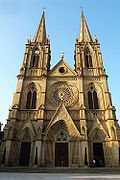 Shishi Sacred Heart Cathedral
Shishi Sacred Heart Cathedral
-
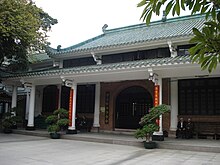 The Huaisheng Mosque
The Huaisheng Mosque
-
Western style architecture on Shamian Island
-
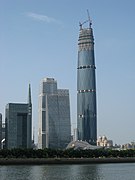 Towers in Guangzhou's CBD (left-center) with IFC/West Tower (right) and Guangzhou Opera House (front) under construction
Towers in Guangzhou's CBD (left-center) with IFC/West Tower (right) and Guangzhou Opera House (front) under construction
-
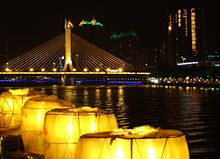 Pearl River at night
Pearl River at night
-
 Canton Tower, June 2009
Canton Tower, June 2009
-
Front entrance to the Baiyun Mountain or Mount Baiyun
Media
Guangzhou has two local radio stations: the provincial Radio Guangdong and the municipal Radio Guangzhou. Together they broadcast in more than a dozen channels. The primary language of both stations is Cantonese. Traditionally only one channel of Radio Guangdong is dedicated to Mandarin (Putonghua). However, in recent years there has been an increase of Mandarin programmes in most Cantonese channels. Radio stations from cities around Guangzhou mainly broadcast in Cantonese and can be received in different parts of the city, depending on the radio stations' locations and transmission power. On the other hand, the Beijing-based China National Radio broadcasts Mandarin programmes in the city. Radio Guangdong also produces a 30-minute weekly English programme, Guangdong Today, which is broadcast globally through the WRN Broadcast. Daily English news programmes are also broadcast by Radio Guangdong.
Guangzhou has some of the best Chinese-language newspapers and magazines in mainland China, most of which are published by three major newspaper groups in the city. The Guangzhou Daily Press Group, Nanfang Press Corporation and Yangcheng Evening News Group dominate the newspaper market of the province. The two leading newspapers of the city are Guangzhou Daily and Southern Metropolis Daily. The former, with a circulation of 1.8 million, has been China's most successful newspaper for 14 years in terms of advertising revenue, while Southern Metropolis Daily is considered one of the most liberal newspapers in mainland China. In addition to Guangzhou's Chinese-language publications, there are a few English magazines and newspapers, most notably that's PRD (formerly that's Guangzhou) which was started more than a decade ago and has since blossomed into one of China's leading expat magazines with issues in Beijing, Shanghai and formerly Suzhou, but also including the more recent 'In The Red' magazine, which has been in circulation for a couple of years as of 2013.
Education
Main article: List of universities and colleges in GuangdongHigher educational institutes

Universities and colleges
- Guangdong Institute of Science and Technology
- Guangdong Pharmaceutical University
- Guangdong Polytechnic Normal University (广东技术师范学院)
- Guangdong University of Business Studies
- Guangdong University of Finance (广东金融学院)
- Guangdong University of Foreign Studies
- Guangdong University of Technology
- Guangzhou Academy of Fine Arts
- Guangzhou Medical College (广州医学院)
- Guangzhou Sports University
- Guangzhou University
- Guangzhou University of Chinese Medicine
- Jinan University (founded in 1906)
- South China Agricultural University (founded in 1909)
- South China Normal University
- South China University of Technology
- Southern Medical University (founded in 1951)
- Sun Yat-sen University (founded in 1924)
- Xinghai Conservatory of Music
- Zhongkai University of Agriculture and Engineering
Note: Institutes without full-time bachelor programs are not listed.
Guangzhou Higher Education Mega Centre
Guangzhou Higher Education Mega Centre also known as Guangzhou University Town is a large tertiary education complex located in the southeast suburbs of Guangzhou. This huge higher education centre occupies the entire Xiaoguwei island in Panyu District, covering an area of about 18 square kilometres (7 sq mi). It houses new campuses from ten higher education institutions. The whole Higher Education Mega Centre can eventually accommodate up to 200,000 students, 20,000 teachers and 50,000 staff.
Higher education institutions with campuses in the Mega Centre:
- Guangdong Pharmaceutical University
- Guangdong University of Foreign Studies
- Guangdong University of Technology
- Guangzhou Academy of Fine Arts
- Guangzhou University
- Guangzhou University of Chinese Medicine
- South China Normal University
- South China University of Technology
- Sun Yat-sen University
- Xinghai Conservatory of Music
Sports

In 2010, Guangzhou hosted the 16th Asian Games from November 12 to 27 and the first Asian Para Games from December 12 to 19, which were the largest sporting events the city ever hosted.
Guangzhou also hosted the following major sporting events:
- 1987 The 6th National Games of the People's Republic of China
- 1991 The 1st FIFA Women's World Cup
- 2001 The 9th National Games of the People's Republic of China
- 2007 The 8th National Traditional Games of Ethnic Minorities of the People's Republic of China
- 2008 The 49th World Table Tennis Championships
- 2009 The 11th Sudirman Cup: the world badminton mixed team championships
Current professional sports clubs based in Guangzhou include:
Guangzhou Evergrande F.C.
Guangzhou Evergrande F.C. is currently the most successful football team in Asia, having won three consecutive national titles in 2011, 2012 and 2013. The team is also the current Asian champion after winning the 2013 AFC Champions League. The club competed in the 2013 FIFA Club World Cup, where it lost 3–0 at the semi-final stage to 2012–13 UEFA Champions League winner FC Bayern Munich.
Household registration policy
Main article: Hukou systemChina's system of household registration, also known as a "hukou," restricts the ability of Chinese citizens to freely choose their place of residence and determines eligibility for education and other public benefits. In May 2014, the municipal agencies in Guangzhou responsible for population control, human resources, social security, and civil affairs issued a notice to local state-run employment agencies and family planning centers. The notice stated that those legally employed in Guangzhou should be issued an individual "hukou card" that allows them to marry and obtain permission to have children instead of requiring them to return to their official place of residence. These rules apply to workers in all occupations. Reports in the Chinese media said about 100,000 were affected by these changes.
See also
- 2013 Southern Weekly incident
- Africans in Guangzhou
- Canton, for namesakes
- Fernão Pires de Andrade
- Guangzhou Television Cantonese controversy
- List of twin towns and sister cities in China
- Rafael Perestrello
- Seamen's strike of 1922
- World's largest cities
References
 This article incorporates text from On the knowledge possessed by the ancient Chinese of the Arabs and Arabian colonies: and other western countries, mentioned in Chinese books, by E. Bretschneider, a publication from 1871, now in the public domain in the United States.
This article incorporates text from On the knowledge possessed by the ancient Chinese of the Arabs and Arabian colonies: and other western countries, mentioned in Chinese books, by E. Bretschneider, a publication from 1871, now in the public domain in the United States.
- ^ "土地面积、人口密度(2008年)". Statistics Bureau of Guangzhou. Retrieved February 8, 2010.
- ^ "广州市2010年第六次全国人口普查主要数据公报" (in Chinese). Statistics Bureau of Guangzhou. May 16, 2011. Retrieved May 25, 2011.
- "2010年广州市国民经济和社会发展统计公报" (in Chinese). Statistics Bureau of Guangzhou. April 7, 2011. Retrieved May 25, 2011.
- "Guangzhou (China)". Encyclopædia Britannica. Accessed September 12, 2010.
- "Illuminating China's Provinces, Municipalities and Autonomous Regions". PRC Central Government Official Website. Retrieved May 17, 2014.
- ^ "Tourism Administration of Guangzhou Municipality". visitgz.com. Retrieved March 21, 2010.
- "全国乡镇规划确定五大中心城市". Southern Metropolitan Daily. February 9, 2010. Retrieved July 29, 2010.
- "中央机构编制委员会印发《关于副省级市若干问题的意见》的通知. 中编发[1995]5号". 豆丁网. February 19, 1995. Retrieved May 28, 2014.
- Th. Brinkhoff (April 5, 2011). "The Principal Agglomerations of the World – Population Statistics & Maps". Citypopulation.de. Retrieved August 13, 2011.
- "The 2008 Global Cities Index". Foreign Policy. October 15, 2008. Retrieved June 2, 2011.
- Zhongguo Gujin Diming Dacidian 中国古今地名大词典, 2005. (Shanghai: Shanghai Cishu Dacidian), 2901.
- 刘煦.旧唐书·王方庆传〔M〕.北京:中华书局,1975
- 杜佑.通典:卷191〔M〕.北京:中华书局,1984
- H·Yule, Cathay and the Way Thither Vol. 1〔M〕. London: Hakluyt Society, 1916.
- E. Bretschneider (1871). On the knowledge possessed by the ancient Chinese of the Arabs and Arabian colonies: and other western countries, mentioned in Chinese books. London: Trübner & Co. p. 10.
- Welsh, Frank (1974). Maya Rao (ed.). A Borrowed Place: The History of Hong Kong. p. 13. ISBN 1-56836-134-3.
- Needham, Joseph (1954). Science & Civilisation in China. Cambridge University Press. pp. 1, 179.
- Sima Guang. Zizhi Tongjian (Comprehensive Mirror to Aid in Government).
- Gabriel Ferrand, ed. (1922). Voyage du marchand arabe Sulaymân en Inde et en Chine, rédigé en 851, suivi de remarques par Abû Zayd Hasan (vers 916). p. 76.
- Kaifung Jews. Division of Religion and Philosophy. University of Cumbria.
- أبوزيد حسن السيرافي ،"رحلة السيرافي"،المجمع الثقافي، أبو ظبي، عام 1999م
- Tōyō Bunko (Japan). Kenkyūbu (1928). Memoirs of the Research Department of the Toyo Bunko (the Oriental Library), Issue 2. Ann Arbor, Michigan: The Toyo Bunko. p. 34. Retrieved February 9, 2011.
- Lombard-Salmon Claudine (2004). Les Persans à l'extrémité orientale de la route maritime (IIe A.E. -XVIIe siècle). Archipel. Volume 68. p. 40. Retrieved March 3, 2011.
- Société pour l'étude et la connaissance du monde insulindien, Association Archipel, Centre de documentatio et de recherches sur l'Asie du Sud-Est et le monde indonésien, Centre national de la recherche scientifique (France), Institut national des langues et civilisations orientales, École des hautes études en sciences sociales (2004). Archipel, Issues 67–68. SECMI. p. 40. Retrieved March 3, 2011.
{{cite book}}: CS1 maint: multiple names: authors list (link) - History of Science Society, Académie internationale d'histoire des sciences (1939). Isis, Volume 30. Publication and Editorial Office, Dept. of History and Sociology of Science, University of Pennsylvania. p. 120. Retrieved February 9, 2011.
- تحفة النظار في غرائب الأمصار وعجائب الأسفار,ابن بطوطة,ص 398
- Denis Crispin Twitchett, John King Fairbank, "The Cambridge history of China, Volume 2; Volume 8", Cambridge University Press, 1978, ISBN 0-521-24333-5
- Ring & Salkin & La Boda 1996, p. 306.
- "Top 10 Cities of the Year 1800". About.com. Retrieved August 28, 2008.
- Kohn, George C. (2008). Encyclopedia of plague and pestilence: from ancient times to the present. Infobase Publishing. p. 165. ISBN 0-8160-6935-2.
- "Baiyun Mountain Scenic Area". Baiyunshan.com.cn. Retrieved September 11, 2013.
- Cite error: The named reference
Mherrerawas invoked but never defined (see the help page). - ^ "部分年份城乡人口分布". 广东省志:人口志 (in Chinese). Local Records Office of Guangdong. Retrieved August 4, 2011.
- ^ "广州市商业网点发展规划主报告(2003–2012)(下篇)" (PDF) (in Chinese). Department of Market System Development, Ministry of Commerce of the People's Republic of China. Retrieved August 4, 2011.
- ^ "统计年鉴2012" (in Chinese). Statistics Bureau of Guangzhou. September 2012. Retrieved July 9, 2013.
- "Guangzhou and Foshan signed "City Merge Cooperation Framework"". News.xinhuanet.com. Retrieved May 6, 2010.
- "广东统计年鉴2010". Gdstats.gov.cn. Retrieved June 2, 2011.
- ^ "RightSite.asia". RightSite.asia. Retrieved May 6, 2010.
- "RightSite.asia". RightSite.asia. Retrieved May 6, 2010.
- "Guangzhou's Remarkable Bus Rapid Transit System". Reuters. April 5, 2011. Retrieved April 15, 2011.
- "Case Study of the Guangzhou BRT". International Public Transport Conference 2010. Retrieved August 5, 2010.
- "Guangzhou expects to run all buses and taxis on LPG for Asiad". Official website of the Chinese Olympic Committee. July 17, 2009. Retrieved March 20, 2013.
- Autobusy zasilane LPG w Polsce - InfoBus. Infobus.pl (2012-06-22). Retrieved on 2014-06-23.
- "Guangzhou Bans Motorcycles". Life of Guangzhou. January 3, 2007. Retrieved August 28, 2008.
- "Traffic Jam Improve after Motorcycle Ban". Life of Guangzhou. January 19, 2007. Retrieved August 28, 2008.
- "http://www.newsgd.com/specials/airportguide/airportnews/content/2009-06/01/content_5204382.htm". NEWSGD.com. June 1, 2009. Retrieved March 6, 2010.
{{cite news}}: External link in|title= - Branigan, Tania (July 25, 2010). "Protesters gather in Guangzhou to protect Cantonese language". The Guardian. London.
- "Migrants In Guangzhou". English.cri.cn. Retrieved March 12, 2013.
- "回眸:当年传教士进羊城-MW悦读室之岭南话廊-凤凰网博客" (in Simplified Chinese). Blog.ifeng.com. Retrieved March 12, 2013.
- "合信的《全体新论》与广东士林-《广东史志》1999年01期-中国知网" (in Simplified Chinese). Mall.cnki.net. February 3, 2012. Retrieved March 12, 2013.
- "Full text of "Hand book of Methodist missions"". Archive.org. Retrieved March 12, 2013.
- "George PIERCY 1829–1913". Turle.name. November 29, 2008. Retrieved March 12, 2013.
- http://www.methodist.org.hk/media/monthlynews/pdf/2011/10/24/2011Methodist_eng_issue3_for_web.pdf
- Inasmuch: Mary H. Fulton, The United Study of Forring. Amazon.com. April 6, 2010. ISBN 9781140341802. Retrieved September 11, 2013.
- "中国近代第一所女子医学院--夏葛医学院-【维普网】-仓储式在线作品出版平台-www.cqvip.com". Cqvip.com. Retrieved March 12, 2013.
- A crusade of compassion for the healing. Books.google.com. September 15, 2010. Retrieved September 11, 2013.
- "柔济医院的实验室_新闻_腾讯网" (in Simplified Chinese). News.qq.com. January 17, 2012. Retrieved March 12, 2013.
- Rebecca Chan Chung, Deborah Chung and Cecilia Ng Wong, "Piloted to Serve", 2012
- Piloted to Serve39 likes · 4 talking about this. "Piloted to Serve". Facebook. Retrieved March 12, 2013.
{{cite web}}: CS1 maint: numeric names: authors list (link) - "Charaktereigenschaften der Guangzhouer – Guangzhou – Deutschabteilung Der SYSU". Fls.sysu.edu.cn. October 9, 2007. Retrieved August 28, 2011.
- "Six Banyan Trees Temple – Famous Buddhist temple of Guangzhou". Excelguangzhou.com. Retrieved August 28, 2011.
- "Viii. Appendix Ii". China.hrw.org. December 28, 1997. Retrieved August 28, 2011.
- "CHINA Beijing and Guangzhou attack underground Churches – Asia News". Asianews.it. Retrieved August 28, 2011.
- "Travel China Guide: Fascinating Guangzhou". Blogspot. August 12, 2008. Retrieved August 21, 2008.
- "GZ's New Television Tower Named Canton Tower". 2010-09-30. Retrieved October 5, 2010.
- "Mega Campus goes Wireless" (PDF). Intel Corporation. Archived from the original (PDF) on February 27, 2008. Retrieved August 28, 2008.
- "Bayern Munich's Franck Ribéry leads rout of Guangzhou Evergrande". The Guardian. December 18, 2013.
- Tatlow, Didi Kirsten (July 9, 2014). "Go South to Guangzhou, a 'Home' Away From Home". New York Times. New York, New York. Retrieved July 10, 2014.
Further reading
- Foster, Simon; Lin-Liu, Jen; Pham, Sherisse (February 12, 2010). Frommer's China. United States: 2000–2010 by Frommer's/Wiley Publishing, Inc. pp. 542–. ISBN 978-0-470-52658-3. Retrieved March 21, 2010.
{{cite book}}: Cite has empty unknown parameters:|laydate=,|laysummary=, and|authormask=(help); External link in|publisher=|coauthors=ignored (|author=suggested) (help) - Johnson, Graham E. (1999). Historical Dictionary of Guangzhou (Canton) and Guangdong. Lanham, MD: The Scarecrow Press. ISBN 978-0-8108-3516-0.
- Lee, Edward Bing-Shuey (1936). Modern Canton. Shanghai: The Mercury Press.
- Ng, Yong Sang (1936). Canton, City of the Rams: A General Description and a Brief Historical Survey. Canton: M.S. Cheung. ASIN B0008D1HHO.
- Ring, Trudy; Salkin, Robert M.; La Boda, Sharon, eds. (1996). International Dictionary of Historic Places: Asia and Oceania. Vol. Volume 5 of International Dictionary of Historic Places (illustrated, annotated ed.). Taylor & Francis. ISBN 1884964044. Retrieved April 24, 2014.
{{cite book}}:|volume=has extra text (help); Invalid|ref=harv(help) - Shaw, Samuel; Josiah Quincy (1847). The journals of Major Samuel Shaw : the first American consul at Canton : with a life of the author. Boston: Wm. Crosby and H.P. Nichols. Retrieved April 5, 2008.
- Vogel, Ezra F. (1969). Canton Under Communism: Programs and Politics in a Provincial Capital, 1949–1968. Cambridge, MA: Harvard University Press. ISBN 978-0-674-09475-8.
- Mrs. John Henry Gray (1880). Fourteen months in Canton. London : Printed by William Clowes and Sons, Stamford Street and Charing Cross: Macmillan and co. p. 444. Retrieved March 21, 2012.London : Macmillan and Co., 1880. Original from Harvard University Digitized Oct 14, 2008
- John Henry Gray (1875). Walks in the city of Canton. De Souza & Co. p. 695. Retrieved March 21, 2012.Victoria, Hong Kong : De Souza & Co. 1875. Original from the New York Public Library Digitized Apr 2, 2008
External links
- Guangzhou International: Official website of government of Guangzhou municipality
- Guangzhou, China Network
- Guangzhou Network
- Guangzhou Municipal Bureau of Tourism
- Photos of Old Canton (20th century) and also of the Sino-Japanese War from a Presbyterian mission near Canton
| Preceded byN/A | Capital of Nanyue Nanyue 204–111 BC |
Succeeded byN/A |
| Preceded byFengtian | Capital of China Republic of China 1 July 1925 – 21 February 1927 |
Succeeded byWuhan |
| Preceded byTaiyuan | Capital of China Republic of China 28 May 1931 – 22 December 1931 |
Succeeded byChongqing |
| Preceded byNanjing | Capital of China Republic of China 23 April 1949 – 14 October 1949 |
Succeeded byChongqing |
| Places adjacent to Guangzhou | ||||||||||||||||
|---|---|---|---|---|---|---|---|---|---|---|---|---|---|---|---|---|
| ||||||||||||||||








